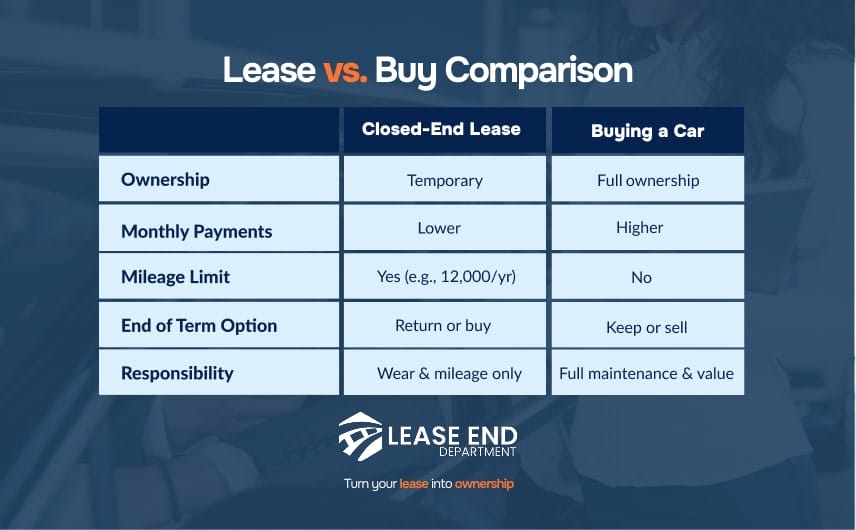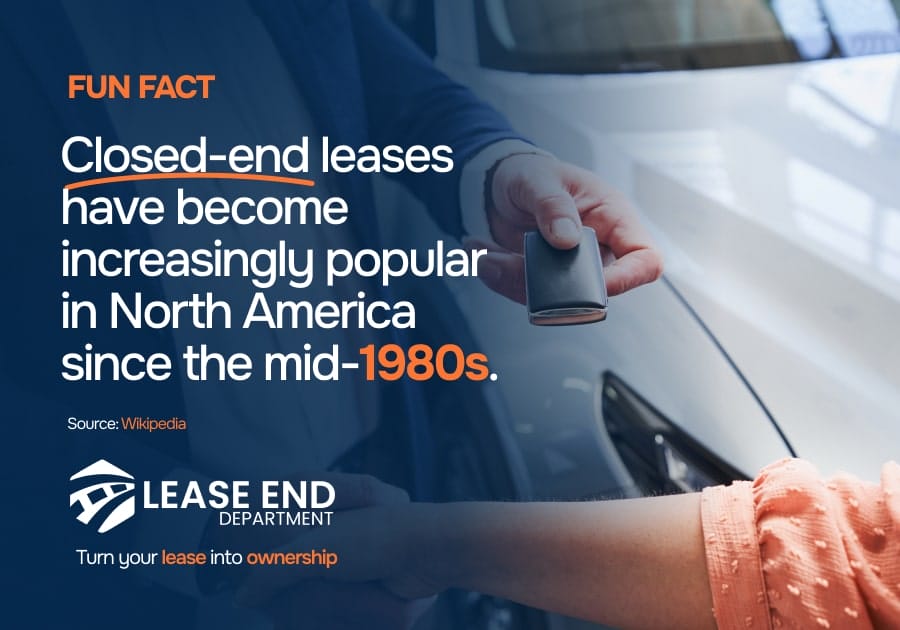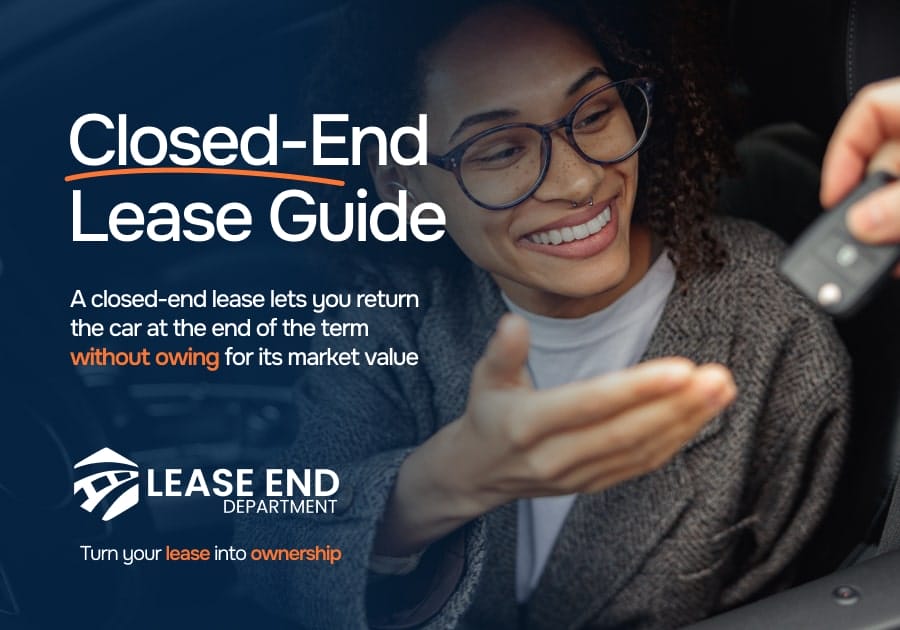Things to Know About Closed End Lease
- A closed-end lease allows you to return the car at the end of the lease with no resale risk, as long as you stay within mileage and wear guidelines
- Closed-end leases differ from open-end leases by placing the future value risk on the leasing company, not the consumer
- Closed-end leases usually have fixed terms ranging from 12 to 48 months
- This lease type is ideal for drivers who want consistent payments and drive predictable mileage each year
- At lease-end, you can return the vehicle, buy it, or explore other options like refinancing
If you’re thinking about leasing a car, you’ve probably come across the term “closed-end lease.”
It’s the most common type of lease available today, but what does it actually mean, and is it the right fit for your lifestyle and budget?
In this article we’ll cover:
- How a closed-end lease works
- The key differences between closed-end and open-end leases
- Benefits and limitations to consider before signing
- What happens when your lease ends
- Tips to make the most of your closed-end lease
How a Closed-End Lease Works in Practice
A closed-end lease works like a long-term rental agreement with clearly defined terms.
You lease a vehicle for a fixed period, typically two to four years and make monthly payments based on the car’s expected depreciation, interest rate (called the money factor), and agreed mileage cap.
What happens during the lease:
- You sign a lease agreement that includes:
- The lease term (usually 24–48 months)
- An annual mileage cap (often 10,000 to 15,000 miles)
- Your monthly payment and any upfront fees
You are responsible for:
- Staying within the mileage limit
- Maintaining the car in good condition
- Making regular lease payments on time
What happens when the lease ends:
- You can return the car with no further obligation
- You may pay fees for excess mileage or wear and tear
- You may be offered the option to purchase the vehicle (lease buyout)
Example: If you lease a $30,000 car for three years with a residual value of $18,000, your payments cover the $12,000 in depreciation (plus interest and fees). If you return the car on time, within mileage limits, and in good condition, you owe nothing more. If you love the car, you can buy it for the $18,000 residual price.


Closed-End Lease vs. Open-End Lease: Key Differences
While both types of leases let you drive a vehicle for a set time, closed end and open-end leases differ significantly in how much financial responsibility you carry at the end.
Here’s how they compare.
Risk and Vehicle Value at Lease-End
With a closed-end lease, the leasing company assumes the risk of the vehicle’s value at the end of the term.
- You can return the car without worrying about market fluctuations
- This works only if you stay within the mileage and wear limits
With an open-end lease, you are responsible for covering the difference if the car’s market value is lower than the estimated residual value.
- This lease type is more common in commercial or high-mileage situations where resale value is harder to predict
Example: If the residual value is $18,000 but the car is only worth $16,000, an open-end lessee may need to pay the $2,000 difference. A closed-end lessee would not.
How Each Lease Type Affects Your Costs
- Closed-end leases offer more predictable costs. Your monthly payment is fixed, and your responsibility ends at lease return unless there is excess wear or mileage.
- Open-end leases often come with lower monthly payments, but the uncertainty of the final vehicle value can result in unexpected costs.
Key point: Closed-end leases are better for those who prioritize financial predictability. Open-end leases might appeal to businesses or drivers who understand the resale risks.
Choosing the Right Lease for Your Situation
Choose a closed-end lease if you:
- Want fixed monthly payments
- Drive within a set mileage range
- Prefer not to worry about resale value
- Consider an open-end lease if you:
- Drive significantly more than 15,000 miles per year
- Lease for business or fleet purposes
- Are willing to manage the risk at the end
In most consumer cases, a closed-end lease is the smarter and safer choice, especially if you’re planning to return or potentially buy out the car at lease-end.


Key Terms To Know for Closed-End Leases
A closed-end lease is the most common type of consumer auto lease.
Key terms to know in a closed-end lease include:
- Residual value: The projected value of the vehicle at lease-end
- Mileage limit: Most closed-end leases allow 10,000 to 15,000 miles per year
- Disposition fee: A fee charged if you return the car at the end of the lease
- Wear-and-tear guidelines: Standards you must meet to avoid extra fees when returning the car
Tips for Getting the Most Out of a Closed-End Lease
A closed-end lease offers predictability and flexibility, but there are a few smart moves you can make to avoid surprises and maximize value throughout your lease term.
Negotiate Favorable Terms Before You Sign
Before signing, take time to negotiate key elements of your lease. You can often negotiate:
- The capitalized cost (selling price of the car)
- The money factor, which affects your interest rate
- Mileage limits and potential excess mileage charges
- Disposition fees and buyout terms
Ask for written confirmation of any agreed-upon changes. The more favorable your terms upfront, the better your experience will be over the lease term.
Stick to Your Mileage and Maintenance Plan
Most leases have mileage limits, usually between 10,000 and 15,000 miles per year.
If you exceed this, you’ll pay 15 to 25 cents per mile.
To avoid excess charges:
- Track your mileage regularly
- Plan your driving if you’re approaching your limit
- Follow your lease’s maintenance schedule to avoid wear-and-tear fees
Staying within the limits and keeping the vehicle in good condition can save you hundreds at lease-end.
Understand Your Buyout Option Early
Many closed-end leases include a buyout clause, letting you purchase the car at a set residual value.
To make the most of this:
- Review the buyout price listed in your lease agreement
- Monitor the market value of your car during the lease
- Decide ahead of time if a buyout makes sense financially
If your car is worth more than the residual value, a buyout can be a cost-effective way to transition to ownership without shopping for a new vehicle.
Closed End Leases: Key Takeaways
- Closed-end leases offer low risk, fixed payments, and no obligation to buy at the end of the term.
- Understanding your contract terms, especially mileage and residual value, can help you avoid fees.
- Compared to open-end leases, closed-end agreements are better suited for everyday drivers who want peace of mind.
- If you love your leased car, a buyout through Lease End Department may be a smart way to keep it with financing that works for you.
How Lease End Department Helps You at Buyout Stage
If you’re nearing the end of your lease and unsure what to do next, Lease End Department makes the transition simple.
Whether you want to buy your leased vehicle, explore financing, or avoid dealership hassles, their team is ready to guide you every step of the way.
Here’s how we help:
- Buy your lease with ease: Share your lease and vehicle details, and Lease End Department will handle the paperwork, financing, and processing, all without dealership pressure.
- Review loan options that fit your budget: You’ll receive tailored financing choices based on your needs, credit profile, and buyout terms.
- Sign documents quickly and securely: Documents are sent directly to you for review and signing, either digitally or by mail. No long waits or in-person appointments required.
- Skip the DMV and save time: We manage title transfers, registration, and license plate delivery, so you don’t have to deal with long lines or confusing paperwork.
With Lease End Department, you keep the car you love and skip the stress.




